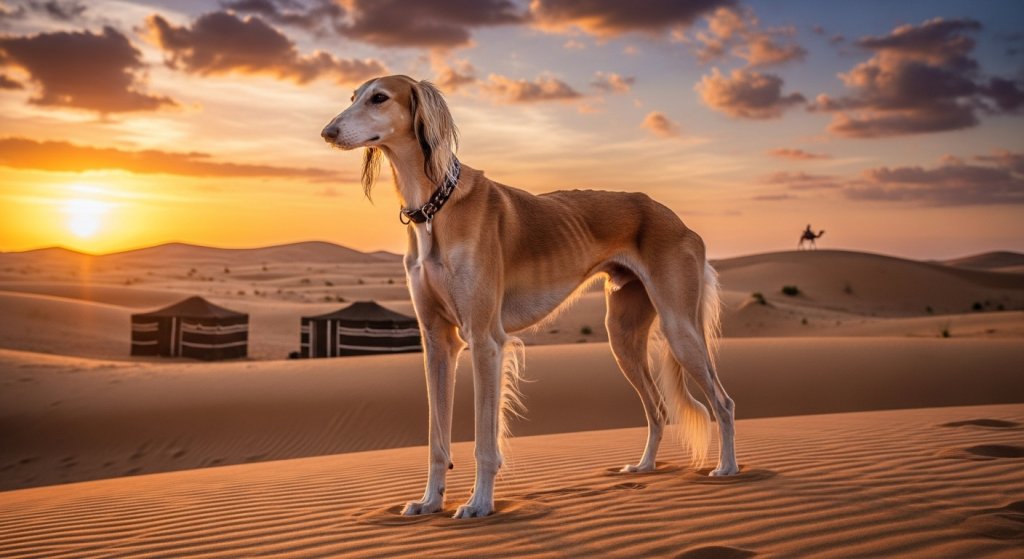Have you ever wondered about the role of a dog in Arab culture, or what a true Arabic dog looks like? The relationship between people and dogs in the Middle East is rich with history and tradition. This article will be your guide to understanding the unique status of the Arab dog, focusing on the famous Arab dog breeds that have been companions to nomadic tribes for centuries.
The Dog in Arab Culture: A Different Story
The role of the dog in Arab culture is more complex than in many other parts of the world. While some Islamic traditions view dogs as ritually impure, a long and rich history of appreciation and respect for them exists, especially in desert life.
Historically, the Arabian dog did not function as a house pet for cuddling. Instead, it was a working animal, a crucial partner for survival in the harsh desert environment. Nomads highly valued these dogs for their skills in:
- Hunting: They were essential for catching game like gazelles and hares. This was a sport and a source of food.
- Guarding: They protected camps and livestock from predators, providing a vital layer of security.
- Companionship: They were loyal and trusted members of the nomadic family unit. In the Bedouin tradition, a dog’s loyalty was seen as a great virtue.
This deep, working relationship is a key part of the story of the Arab dog.
Famous Arabian Dog Breeds
The Middle East is home to some of the world’s most ancient and elegant dog breeds, each perfectly adapted to the desert.
The Saluki: The Noble Arabian Hound
People often call the Saluki the “royal dog of Egypt” or the Arabian hound. It is one of the oldest dog breeds in the world, with a history that goes back over 5,000 years. Nomadic tribes revered it so highly that they believed it to be a gift from Allah.
- Appearance: The Saluki is known for its elegant, slender, and athletic build, built for incredible speed. Its coat can be either smooth or “feathered,” with long silky hair on its ears, tail, and legs.
- Temperament: Salukis are dignified and independent. They are incredibly loyal to their families but can be aloof with strangers. They are quiet and calm indoors but need a lot of space to run and exercise outside.
- Cultural Significance: Nomadic Bedouin tribes highly revered this breed. They considered the Saluki an exception to some religious views on dogs, often calling it al-hor (the noble one). They allowed it to share living spaces with families, even in areas where other dogs were not. The Persian hound is another name for this elegant breed.
The Sloughi: The North African Sighthound
The Sloughi is another ancient breed of sighthound, which people often call the Arabian Greyhound. It originates from North Africa, with roots in countries like Morocco, Algeria, and Tunisia.
- Appearance: Like the Saluki, the Sloughi is a lean and muscular sighthound, built for speed and endurance. It has a short, smooth coat and large, expressive eyes that reflect its gentle nature.
- Temperament: The Sloughi has a reputation for its noble and reserved attitude. It is very loyal and affectionate with its family but can be wary of strangers. It has a strong prey drive, so it is a natural hunter.
- Historical Role: This breed was a prized hunting companion for both nomadic tribes and nobility. They used it to hunt game like hares and gazelles across the vast desert plains. Today, people consider the breed rare and highly value it for its pure bloodlines.
The Canaan Dog: The National Dog of Palestine
The Canaan Dog is an ancient breed native to the land of Israel, Jordan, and the Sinai Peninsula. It is one of the oldest breeds in the world, with its roots tracing back to biblical times.
- Appearance: The Canaan Dog is a medium-sized breed with a thick coat that protects it from extreme temperatures. It has a distinctive bushy tail and a broad head.
- Temperament: This breed has a reputation for its intelligence, loyalty, and protective nature. It is a natural guard dog that is wary of strangers.
- Historical Role: Bedouin tribes historically used this breed as a herding and guarding dog. It is an extremely versatile and hardy breed, perfectly adapted to the desert environment.
Conclusion
The Arab dog has a long and respected place in the history of the Middle East. Breeds like the Saluki, the Sloughi, and the Canaan Dog are more than just pets; they are symbols of nobility, loyalty, and the rich traditions of desert life. Understanding their history gives us a deeper appreciation for the culture of the region. For more insights into Arab culture and to master the language, be sure to download the Kaleela Arabic learning app today!



